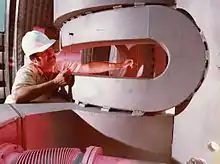Tandem Mirror Experiment
The Tandem Mirror Experiment (TMX and TMX-U) was a magnetic mirror machine operated from 1979 to 1987 at the Lawrence Livermore National Laboratory.[1] The machine trapped ions and electrons between two magnetic mirrors. Ions would bounce back and forth in a line, collide in the center and fuse. This was an early experiment towards fusion power.
| Tandem Mirror Experiment | |
|---|---|
 The Tandem Mirror Experiment (TMX) in 1979 | |
| Device Type | Magnetic mirror |
| Location | Livermore, California, U.S. |
| Affiliation | Lawrence Livermore National Laboratory |
| History | |
| Date(s) of construction | 1977 – 1979 |
| Year(s) of operation | 1979–1987 |
| Preceded by | 2XIIB |
| Related devices | Mirror Fusion Test Facility (MFTF) |
History
The design of a magnetic mirror machine was first published in 1967.[2] The concept was developed in the US by Richard F. Post and his team at Lawrence Livermore National Laboratory during the late sixties.[3] Partially due to the 1970s energy crisis and the Cold War the funding was available for a massive magnetic mirror and magnetic bottle research program. This led to a series of machines starting in the late 1960s and continuing into the mid eighties. This included the 2X magnetic bottle and Baseball I, Baseball II mirror machines before the TMX was built.[4]
Design

The TMX was formally proposed by Fred Coensgen and the Livermore team on January 12, 1977 to the US Energy Research and Development Administration.[5] The project was projected to cost 11 million dollars. The design consisted of five rings of current around the plasma. The ends uses shaped "Baseball" magnets at the end to stop plasma from escaping. This design produced magnetic forces that increase in every direction away from the center of the mirror region. A fusion plasma shaped like a twisted bow tie is confined inside a magnetic mirror.[6] Designing appropriate plugs was a challenge for all magnetic mirror machines. The baseball design was later replaced by the exotic yin-yang magnets of the MFTF.[7] Problems with escaping plasma led researchers towards the Tokamak where plugs were eliminated by looping the field together.
Confinement
The TMX attempted to use an "ambipolar" plasma. Ideally, this allowed it to contain electrons and ions differently.[8] Because the ions are so much more massive than the electrons they can exist with different speeds simultaneously. Ideally, the TMX attempted to contain the ions primarily with magnetic mirrors and the slow electrons by attracting them to the trapped ions.[8] A variation on this magnetic and electrostatic confinement is also being attempted in the Polywell.
TMX-U
A summary of results from the TMX was published in February 1981.[9] At this time, the facility underwent a major overhaul. A thermal barrier was added to better contain the plasma, the number of rings was increased to over ten[10] the vacuum and diagnostic system was overhauled and extra magnets were added to plug up losses.[11] The new machine was referred to as the "TMX-U"[12] and it operated into the late eighties.
Criticism
Lawrence Lidsky famously criticized the magnetic mirror machines by saying: "They kept adding one set of magnets a year until it collapsed under its own weight"[1] and in his article "The Trouble With Fusion."
Further reading
- "Tandem Mirror experiment with thermal barriers" G A Carlson, UCRL-52836, September 19, 1979.
- "Thermonuclear confinement systems with twin mirror systems" by G I Dimov, Soviet journal of plasma physics, volume 2 number 4
- "Ion Losses from End-Stopped Mirror Trap" DP Chernin, MN Rosenbluth, Institute for Advanced Study, Nuclear Fusion 1978
- "Improved Tandem Mirror Fusion Reactor" By D E Baldwin, Physical Review Letters, October 29, 1979.
References
- Booth, William (1987). "Fusion's $372-Million Mothball". Science. 238 (4824): 152–155. Bibcode:1987Sci...238..152B. doi:10.1126/science.238.4824.152. PMID 17800453.
- Kelley, G G (1967). "Elimination of ambipolar potential-enhanced loss in a magnetic trap". Plasma Physics. 9 (4): 503–505. doi:10.1088/0032-1028/9/4/412. ISSN 0032-1028.
- Post, R. F. (1970-01-01), "Mirror systems: fuel cycles, loss reduction and energy recovery", Nuclear fusion reactors, Conference Proceedings, Thomas Telford Publishing, pp. 99–111, doi:10.1680/nfr.44661, ISBN 978-0-7277-4466-1
- Krall, Nicholas A.; Trivelpiece, Alvin W.; Gross, Robert A. (1973). "Principles of Plasma Physics". American Journal of Physics. 41 (12): 1380–1381. Bibcode:1973AmJPh..41.1380K. doi:10.1119/1.1987587. ISSN 0002-9505.
- "TMX MAJOR PROJECT PROPOSAL" Fred Coensgen, January 12, 1977, LLL-Prop-148
- "Tandem Mirror Experiment (TMX)". January 1978.
- Kozman, T.; Wang, S.; Chang, Y.; Dalder, E.; Hanson, C.; Hinkle, R.; Myall, J.; Montoya, C.; Owen, E.; Palasek, R.; Shimer, D. (1983). "Magnets for the mirror fusion test facility: Testing of the first yin-yang and the design and development of other magnets". IEEE Transactions on Magnetics. 19 (3): 859–866. Bibcode:1983ITM....19..859K. doi:10.1109/tmag.1983.1062533. ISSN 0018-9464.
- "Comments on plasma physics and controlled fusion" Burton D Fried, comments on Plasma physics and controlled fusion, 1977, Volume 2, Number 6
- Simonen, T.C, ed. (1981-02-26). "Summary of results from the Tandem Mirror Experiment (TMX)". doi:10.2172/5759138. Cite journal requires
|journal=(help) - Allen, S.L.; Correll, D.L.; Hill, D.N.; Kaiser, T.B.; Heifetz, D.B. (1987). "Determination of ambipolar radial transport from the particle balance in the TMX-U tandem mirror". Nuclear Fusion. 27 (12): 2139–2152. doi:10.1088/0029-5515/27/12/013. ISSN 0029-5515.
- Pickles, W L (1983). "The LLNL tandem mirror experiment (TMX) upgrade vacuum system". Vacuum. 33 (6): 345. doi:10.1016/0042-207x(83)90122-7. ISSN 0042-207X.
- Hunt, A. L.; Coffield, F. E.; Pickles, W. L. (1983). "Fast pressure measurements for the TMX‐U fusion experiment". Journal of Vacuum Science & Technology A: Vacuum, Surfaces, and Films. 1 (2): 1293–1296. Bibcode:1983JVSTA...1.1293H. doi:10.1116/1.572092. ISSN 0734-2101.